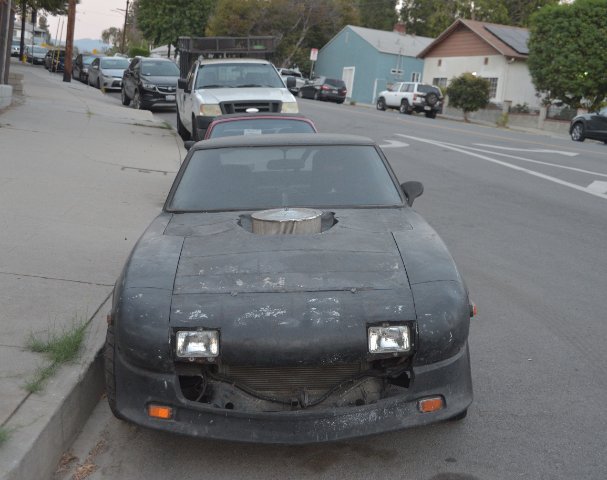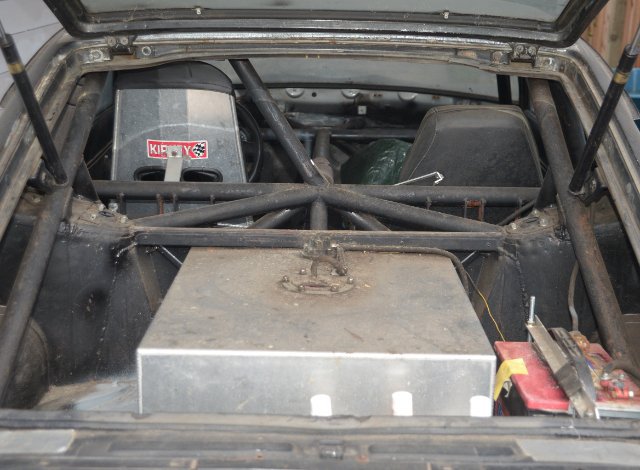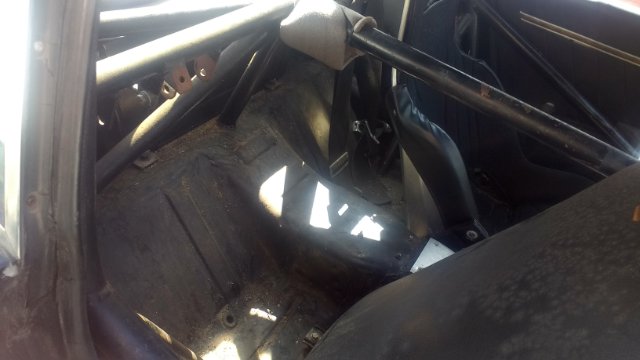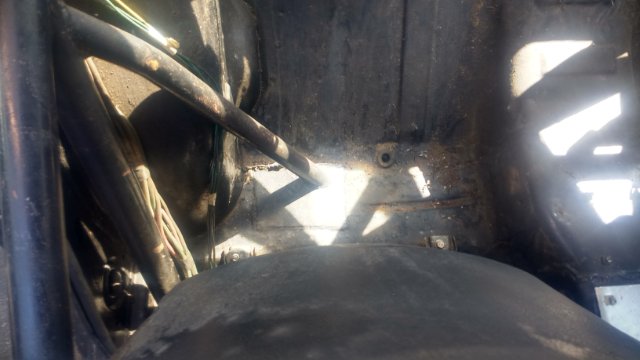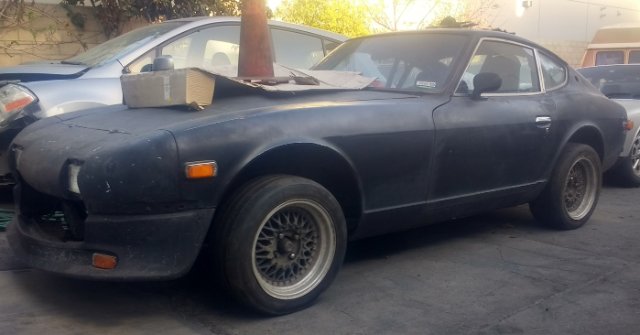-
Posts
825 -
Joined
-
Last visited
-
Days Won
7
Content Type
Profiles
Forums
Blogs
Events
Gallery
Downloads
Store
Everything posted by Michael
-
OK, here's a question on carb tuning. This past summer I visited a local tuning-shop, with open ended question about whether to rebuild my poorly-running carb (a Holley vacuum-secondary 750 cfm, basic model) or to buy something else. The technician recommended something with annular discharge boosters.... wouldn't even talk about anything else. Those are nice pieces... but also expensive. Asking AI, for annular vs. downleg, I get the standard AI answer: part obvious, part irrelevant, part condescending, part generic. How about human intelligence? So... who's running an annular discharge carb, such as this one: https://www.holley.com/products/fuel_systems/carburetors/street_strip/parts/Q-750-AN?utm_term=&utm_campaign=Holley+-+Non-Brand+All+SKUs+Performance+Max&utm_source=google&utm_medium=cpc&hsa_acc=7848552874&hsa_cam=22795333857&hsa_grp=&hsa_ad=&hsa_src=x&hsa_tgt=&hsa_kw=&hsa_mt=&hsa_net=adwords&hsa_ver=3&gad_source=1&gad_campaignid=22795335240&gbraid=0AAAAAD1FzSrgg0ZyXizSf4N8XZyF0lFbQ&gclid=Cj0KCQiArOvIBhDLARIsAPwJXOaTarreYIfCzmnZukhFJ0DfE902wysmGZtkPzPe60nCkk0bztd8cPkaAlw2EALw_wcB ? Oh, and good luck asking such questions in our "fuel delivery" subforum!
-

Help me evaluate this car for sale
Michael replied to z_noob's topic in S30 Series - 240z, 260z, 280z
Also not a facebook user here, but speaking in generalities: 1. In 2025, I would think seriously about the value proposition of buying a Z. Some of us have been dabbling in this hobby/affliction for nearly 30 years, starting back when these cars were cheap, plentiful in junkyards, and blank-canvases for modification. And today? Completely different game. Hard to tinker with a 50 year old car, just as a tinkering-car. Even harder to get the performance out of it, that was the stuff of our dreams in the 1990s. 2. These cars are becoming expensive. Even woebegone projects are becoming expensive. For the less-familiar, it's a costly trap! -
And there we have it! A full quarter century old! Old enough, to run for the US House of Representatives!
-
For people who still run old-school large-displacement V8s (we still exist, right?)... any thoughts on the somewhat-new (been around for 5-6 years) Edelbrock AVS2 carb? This has annular boosters on the primary-side, as opposed to dog-leg. Some articles here: https://www.motortrend.com/how-to/1908-inside-look-new-edelbrock-avs2-carburetor/ and here: https://www.hotrod.com/how-to/tuning-edelbrock-avs2-carb/ . The objective is throttle response, part-throttle drivability, and overall good manners with minimal fussing/tuning. Application is my perpetually-under-repair 454. I'd be looking at the 800 cfm version with manual choke. BTW, there are a few mentions of the AVS carb on HybridZ, but they're from 2014 and earlier.. for the old-style AVS (dog leg boosters on the primaries), for example here: https://forums.hybridz.org/topic/42427-edelbrock-issues/#comment-352025.
-
Ben, long-term projects take... a long term. So, here's another long-term voice of support! We're almost a quarter of the way done with the 21st century. Some folks started their Z projects back in the 20th century; should hopefully be done, in one capacity or another, before the 22nd! Question: what was wrong with the megasquirt, in terms of successfully operating your LS engine? And what does the Haltech do, that renders the improvement?
-

Long time, No SEZ - (Old Timers SEZ Shootout Roll Call) - just for kicks
Michael replied to Warren's topic in Non Tech Board
Not a participant myself, but I remember announcements for such events... and the era when "hybrid" meant engine from Brand A, into body of Brand B... having nothing to do with electric and internal combustion motors together in one vehicle. The competitive events, together with forums, seem to have been sadly vitiated. Most postings on this forum are now the occasional pop-up of elementary questions, that had been rigorously answered 20 years ago... or idle reminiscences, such as my own. And so many of the most senior/venerable/knowledgeable members have left, outright died, or just gone silent. What happened over the past 23 years? Well, some of us are still working on the same car that we had back in the 20th century... slowly. May one day even race it! -
One of the perennial debates is (or rather was, when this Forum was more active!) about front-rear weight distribution vs reducing polar moment of inertia. If the really heavy components, namely engine and transmission, move aft, then presumably the polar moment of inertia is reduced, even if the weight distribution becomes aft-biased. So, suppose that the car comes out to 47/53. Is that necessarily a disadvantage by itself? If so, is it a disadvantage if in combination with lower polar moment of inertia? Many people prefer the aesthetics of wider tires in the rear. Doesn't that actually lend itself to good remedy for being tail-heavy? I mean, it's just an aesthetic thing... but for a tail-heavy car, it might also turn out to be of practical value.
-
Lifeproject, given that you have a sturdy chassis/frame under the car already, would it perhaps be reasonable to cut/notch the firewall, for additional engine setback? That gives you better weight distribution, and more room under the hood... not just for the harmonic-damper issue, but cooling-room in front of the engine.
-
At the risk of being a crusty curmudgeon, what's the advantage of going all of the way to a 15x9 wheel, while limiting the tire series to 205 or 215? Currently I run 15x7 wheels, with 225-series tires... looks to be a decent match, both geometrically and aesthetically. With a 15x9 wheel, wouldn't it make more sense, to install something like a 275/50 tire? Like Hoosier R7, which is one of the few tires available in that size?
-
Not to be obtuse, but what's the benefit to "big tech"? Are they selling a product? If so, this seems like kludged and ineffective advertising. Are they trawling for data? Maybe, but then where's the harmful link that I'm supposed to click. Are they soliciting subscription to some service, or at least, traffic to a site? Again, no link. It just seems to be garbage for garbage's sake.
-
23 years!
-
Plugs did get fouled, before I figured out an enormous error in the ignition timing (off by something like 50 degrees, but that's a story for another thread). They no longer do. Oddly, the atrocious gas mileage is utterly the same, from before recognizing the timing problem, to after it was corrected. And the 2-3 mpg is from babying the car, never exceeding maybe 2500 rpm, never spinning the tires... start off at a traffic light in 3rd gear, then at 25 mph or so, shift to 5th (which is 1:1... it's a Doug Nash 5-speed). Also, there's no gasoline-smell when pulling the dipstick, either before running the engine, or after.
-
Carbureted V8 (1970s style big block Chevy) S30 here, with an older aluminum fuel-cell filled with foam, and mechanical fuel-pump driven off of the crankshaft. The engine runs OK – I think! – but the fuel mileage is atrocious. The manufacturer of the fuel-cell (Triangle Engineering) evidently no longer exists, but the unit much resembles this one, from Jeg’s: https://www.jegs.com/i/JEGS/555/15389/10002/-1?gclid=Cj0KCQjwhY-aBhCUARIsALNIC04c--8Ok-o0WtGmkpOwfZnzSK2Q5oxw3R6kGnD4y0a_MTBccgI4klgaAuATEALw_wcB There is no fuel-level gauge. It’s a single 3/8” fuel-line, no return. Because of the foam in the fuel-cell, I can’t visually inspect the fuel level. But upon filling say 3-4 gallons at a time, I almost invariably run out of gas after maybe at most 10 miles of driving. By “run out of gas”, I mean that the engine dies. Then, moving the carburetor throttle by hand, results in anemic or non-existing squirting into the primaries. This suggests that the carb’s fuel reservoirs are nearly empty. And yes, there’s whiff of fuel in the exhaust, as the engine almost certainly runs rich… but rich enough to get 2-3 mpg at part-throttle around town? So, the question: to diagnose if the fuel is magically evaporating/leaking/going down a wormhole, or actually reaching the carburetor, I would like to have a gauge in-line with the fuel line. Has anyone installed such a thing? Any thoughts? Lessons? A super-sophisticated (and expensive, probably) example is here: https://www.sentronics.com/applications/fuel-consumption-measurement/ . A janky one is here: https://www.amazon.com/DIGITEN-diesel-Liquid-Sensor-Counter/dp/B017CONTVS .
-

big block Z, "across the centuries"
Michael replied to Michael's topic in S30 Series - 240z, 260z, 280z
Thanks! There has indeed be a turning of the generations. Some of the most venerable early-members have either passed on to other engagements, or have literally passed-on. What BTW was your original user-name, if it's OK to ask? My daily driver is a first-gen Miata. The contrast between the Z and the Miata (it's parked immediately behind the Z, in the photo) is remarkable! The Miata feels light and unencumbered. The Z, though weighing 200 pounds less than its stock factory weight, and with a CG further aft than stock (due to firewall setback), feels like a... muscle car. And no, I don't mean the weight of the steering-effort. It's ineffable, but definitely there. Maybe a V8 Miata would have been a better option? Maybe, but that's actually a much harder swap. A local acquaintance bought a Lotus-7 kit car, with a 2.3L 4-cylinder Ford engine. It theoretically has a power to weight ratio comparable to that of the Z, and it's less than half of the weight. But for whatever reason, it feels less elfin and maneuverable than the Miata, but also accelerates less intensely than the Z. So maybe weight, or power to weight, aren't so obviously important - or at least, secondary in importance, to suspension design or driver interface and so on? So much to learn! Sadly, at the moment I'm in a small apartment, with no garage space. This limits tinkering to bare emergencies. Local ordinances mean that cars can't be parked curbside for longer than 72 hours, without moving. That means keeping-up with things, to enable to car to do a lap around the block, hunting for a new parking spot. But even a drive to the local track (Irwindale?) isn't tractable. What would have been great, would be to find a local buddy, to work together and the bounce-around ideas! -

big block Z, "across the centuries"
Michael replied to Michael's topic in S30 Series - 240z, 260z, 280z
It's been nearly a year, so perhaps an update is fitting. Recent changes have been more a matter of maintenance than of car-crafting, modification, enhancement or technical progress. These include a refresh with stock brakes (master cylinder, rear slave cylinders, pads and shoes, front calipers), fixing the leak at the engine oil-pan and timing cover, and raising the driver's seat a bit higher-up, to improve visibility and comfort. The next struggle is figuring out why the accessory belt (water pump and alternator) keeps getting thrown or shredded. I re-trued the races (correct term?) for the water pump pulley, and installed a new alternator and pulley - factory Delco parts. This is all part-number-referenced to a 1978 Chevy Suburban, with 454. One update of note... by word of mouth, the famous Sammy Malouf took a look at my engine. He runs a fancy, high-profile operation, so I could not in good conscience except much attention to a sappy little jalopy like mine. But Sammy took a good hour to listen to the engine, adjust the timing and make other changes/suggestions, each of which were small individually, but substantial in aggregate. This further compounds the fact, that good tuning and attention to detail, are which distinguish a stalled and failed project, from a smashingly successful one. Or in other words, the execution of craftsmanship can be more important than initial engineering an conceptualization. Or still in other words, the better car is that one that's done right, and not necessarily the one that's optimized on paper! Yeah, it only took 24 years to realize that! Here's a photo of the humble machine, on a Los Angeles street.... -

how do you feel your engine swap changes the character of your Z?
Michael replied to thedarkie's topic in Non Tech Board
My 1978 is down to around 2600 lbs... that's aggressively stripped, including cutting off bits from the tub, partially gutted doors, no dash, etc. Granted, that's with a big-block (aluminum heads), beefy mild-steel "roll cage" and very heavy steel bellhousing. An LS would be lighter, but not 500 pounds lighter, right? Yes, batteries still have horrible energy density, but they do have excellent power density. If I were attempting any organized form of racing, other than drag racing, I'd use my 1991 Miata - and not a Z, or a Tesla, or a Corvette or anything like that. Instead, on the street, essentially ALL that matters for me personally, is grin-inducing sharp but brief bursts of acceleration. The big block Z is starting to do that acceptably. In stock form it never had a chance. Electric cars have potential to do it very well. The Tesla that I test drive - the Model 3 Performance - on paper has about the same hp as my big block. And it's 1400 lbs heavier. But at least subjectively, it felt faster. Because I'm not racing in any organized environment, the subjectivity is all that matters! And if we do an apples-to-apples comparison, what does a GT Mustang weigh these days? Or an M3 BMW? Pretty close to that Tesla! The Model S is 1000 pounds heavier. Never had a chance to drive it, but it's reputed to have a 0-60 a full second faster than the Model-3 Performance. 1000 hp in a 5000 lb car. Would my Datsun ever achieve 500 hp in a 2500 lb car? -

how do you feel your engine swap changes the character of your Z?
Michael replied to thedarkie's topic in Non Tech Board
Two data points… A local friend (also a member here) graciously let me drive his basically-stock 260Z. The engine has a more aggressive cam. Wider wheels/tires and maybe upgraded shocks… otherwise stock. The car is beautifully restored, but compared to my daily driver – a 1991 Miata – it feels sluggish and ponderous. Again, I mean this with no offense towards the builder; he did a marvelous job. The “offense”, if there is one, is against the stock S30. Second data point is test-driving a Tesla Model 3 Performance. This thing is nothing short of phenomenal. Yes, it’s heavy and vague at times, but so is a modern M3 or Camaro. The Tesla delivered precisely the sort of punch that I’d love to have from my big-block Z. Speaking of the latter, I finally drove it the other day. It had *nearly* the on-demand acceleration of the Tesla. It was lighter than the stock 260Z, or at least felt lighter. Steering effort was less, and driver position was more comfortable. The extra torque made it feel more “connected”, although the high noise was ghastly uncomfortable. At the risk of getting banned here, my next car will be electric! -
Plan was to start a new fuel cell foam thread, but this thread - despite being 10+ years old - seems ripe for continuation. Triangle Engineering aluminum 20 gallon fuel cell, with foam... bought 23 years ago, sitting sometimes with fuel, mostly without, for about 22 years now, in a humid environment. Probably I should replace the foam, yes? If I don't, at least temporarily, would a standard inline fuel filter handle the "crud"? This is a carbureted engine, no return line, 3/8" feeder line, mechanical pump (driven off of the cam via pushrod), making about 7 psi. I can't find a web page for Triangle Engineering. Are they still in business?
-
I can solder, and I have a basic understanding of control theory (PIDs, root-locus diagrams, pole placement, gain and phase margins, open loop vs. closed loop transfer functions, stability criteria and so on). What I can't do is write Python code or otherwise handle software at any serious level. I'm also terrified of making a blunder... Wrong integral gain and an otherwise stable system goes radically unstable (pole-pair goes into right half plane, due to the integral controller transfer-function block). No idea what that means for an engine... probably nothing gentle. Also, conversion from carb to EFI means a much higher pressure fuel pump (probably stand-alone electric; maybe even in-tank), injectors on rails, the right sensor suite (presumably at least an oxygen sensor in one of the header collectors), a throttle body and so on. Lots of stuff, beyond just a circuit board in a pot-metal box. Coworkers have played with Arduino controllers for basic lab-type of control tasks. Applying that to a car sound intriguing... but complicated. It would be far easier to start wtih a factory EFI car, perhaps? I'm thinking of my 1991 Miata, which has the larger engine, from a 1996, but the original sensors and electronics. It runs rich and is low on power above 4500 rpm or so, probably from intake restrictions and a very confused ECU.
-
At the risk of diluting or derailing this thread, it's worth observing, that over the past 20-25 years, the pantheon of aftermarket electronic engine management systems has become bewilderingly complicated and sophisticated. This is fine for the expert, or even the dedicated hobbyist. But where does this leave the guy who just wants to hop-up his naturally aspirated carbureted engine, to idle better, get slightly better mpg and maybe a flatter torque curve? It seem that that customer base - which, perhaps naively, I'd imagine to be the majority of the hot-rod hobby - isn't being well-served. Why is that?
-

Diff crossmember structural rigidity questions
Michael replied to Zetsaz's topic in Brakes, Wheels, Suspension and Chassis
The main hoop connects to a triangulation between the rocker panels (beams?), forward edge of the wheel wells, and floor. I don't presently have a good photo of the subject area, but here's another shot of the removed "tool box" (shelf?) area: -

Diff crossmember structural rigidity questions
Michael replied to Zetsaz's topic in Brakes, Wheels, Suspension and Chassis
Another case of removing this structure…. By one reckoning, the “tool box” is the upper part of a lateral beam, of which the lower part would be the OEM crossmember featured in this thread. But I take umbrage: this “upper part” connects to the wheel wells… a flimsy structure unrelated to any suspension pickup points. Indeed, I am confounded, as to what structural role this “tool box” plays at all. Instead, some race sanctioning bodies call for a diagonal connection between the main roll hoop the frame rails. This is what’s attempted in the photograph. The “tool box” is removed, a plate is welded the floor, and a diagonal is welded between said plate and the main hoop. Ideally the frame rails would extend to “near” the LCA front pickup point, so these diagonals to some extant react to prevent the LCA pickup points from moving away or toward each other. Still, I would be inclined to retain some facsimile of the OEM crossmember, perhaps duly notched to accept twin exhaust. In the photo below, we're looking just behind the passenger seat (folded forward); the passenger-side wheel well is to the left, and the transmission tunnel to the right. The "tool box" would, if still remaining, have begun just behind the plate to which the diagonal is welded. -

Offsets hurt my brain
Michael replied to 19782plus2's topic in Brakes, Wheels, Suspension and Chassis
The trouble with 225/45 or even 225/50 on 15" wheels is total tire diameter (23" or 23.8", respectively). I suppose that in the front it doesn't much matter, but in the rear, it results in artificially deep gearing, meaning high highway rpms... and reduced grip for drag racing purposes. Something close in diameter to factory-stock would be the M&H 245/55-15 drag radial (https://www.mandhtires.com/index.php?route=product/product&product_id=159), but I'm not sure that this is appropriate for a 7"-wide wheel. Eventually I'd love to get 325/50-15 tires, but that's more of a pipe-dream than a "plan". -

Offsets hurt my brain
Michael replied to 19782plus2's topic in Brakes, Wheels, Suspension and Chassis
Welcome! Just a brief note on backspacing and offset… Add 1” to the nominal wheel width. So, a 15”x8” has 9” lip-to-lip width. Half of that, is 4.5”. If the inner mounting-face of the bolt circle is 4.5” outboard of the inner lip edge, that is 0 offset. It’s also 4.5” backspacing. Confusingly, often we see offset in millimeters but backspacing and width in inches. And unfortunately, most wheels these days are designed for FWD cars, resulting in large positive offset. So, an offset of +25mm means a backspacing of 5.5”. For wide wheels on a Z, we are limited on backspacing, because the wheel rim or the tire sidewall will contact the McPherson strut spring perch. We can roll or cut the fenders, but other than a coilover setup with smaller diameter spring perch, we’re stuck on the inner-side. On my 1978 280Z, with 14x7 wheels with zero offset (thus, 4” backspacing), on the rear, I measure 0.75” between the wheel inner lip and the spring perch. A 15x8 with zero offset (4.5” backspacing) would presumably move the wheel inner lip 0.5” further inboard, meaning that is just barely clears at the wheel. I can not vouch for how it would clear at the tire. Thus on the inner side. On the outer side, it all depends on spring stiffness and ride height. My car is “jacked up”, and there is ample room between the top of the tire and the fender lip. I could probably run “infinite” width tires and not risk contact with the fender lip. Others, especially on lowered cars, may not have such convenience. As a trial-fit, I just installed 15x7s with 225/40-15 tires. The result is a bit… gappy.


